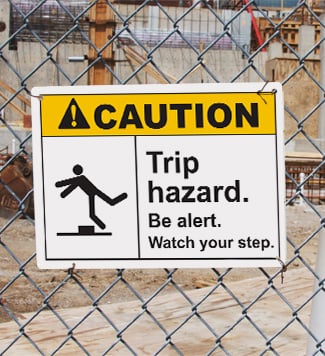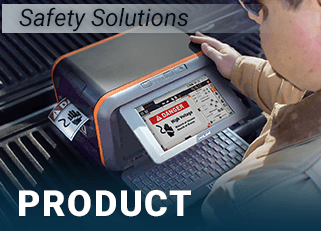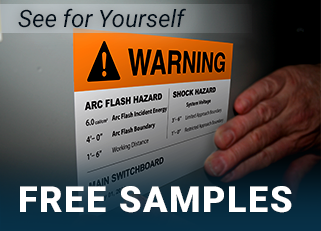Smart Labeling for Construction Projects
03
February,
2023
3 MINUTE READ

Construction signs and labels play a critical role in ensuring the safety of workers and facilitating a smooth hand-off during building projects. Given the complexity of construction sites with multiple contractors, evolving tasks, and dynamic conditions, effective planning for labeling projects is essential to prevent errors and delays. While the prospect of initiating a construction labeling project may seem daunting, it does not have to be a tedious process.
Establish Boundaries:
One of the top priorities in construction projects is maintaining job site cleanliness and ensuring general safety to meet project timelines and stay within budget. Effective communication is key, making labels and signs crucial in promoting a fluid and flexible work environment. The significance of safety in construction was underscored by a record year of injuries and fatalities in 2019. In response, organizations like the American National Standards Institute and safety groups are working to enhance health and safety programs for collaborative construction projects. Recognizing the dynamic nature of risks on construction sites, safety professionals emphasize the importance of engaging the entire project hierarchy in a well-defined safety process.
Planning and Implementation:
Once a comprehensive plan is in place, construction crews can focus on addressing known hazards and improving overall safety. However, identifying the need for labels can be a challenge for some projects. Initiating safety communication from the project's outset establishes a foundation and safety boundaries, saving time and preventing later complications. Safety professional Clark Vermillion emphasizes the need to consider signs and labels early in the construction process, ensuring that they are tracked in the budget from the beginning.
Focus on Communication:
Joseph Addlesberger, a construction safety regional director, highlights the role of signs and labels in preventing injuries and accidents. Clearly defining life-saving actions is crucial, especially in addressing top construction dangers such as fall protection, dropped objects, hot work, and control of hazardous energy. Addlesberger emphasizes the importance of understanding human behavior and maintaining mental fitness for duty to enhance safety on construction sites.
Hidden Hazards and Lean Construction:
Identifying hidden hazards is vital for improving construction site safety. Implementing a system on-site makes it evident what requires labeling, aligning with lean construction methods and sustaining 5S principles. Signs and labels for construction site hazards include providing identification and instructions, such as warnings about power lines, tool and electrical equipment usage, emergency information, and more. Incorporating signs and labels into a daily checklist ensures construction workers stay on task and meet project labeling needs. Ongoing training and awareness programs, along with regular site inspections, help ensure that labels and signs are prominently displayed on pipes, wires, and other critical areas throughout the construction site.
Put the Plan into Action
Here are some tips to remember as you start your labeling and signage project for your construction site:
- Clear and Consistent Communication:
- Use universally recognized symbols, colors, and language for consistency.
- Ensure that signage is easily understood by workers of various backgrounds and language proficiencies.
- Legible and Visible Fonts:
- Choose clear, legible fonts with a size that is easily readable from a distance.
- Ensure good contrast between text and background colors to enhance visibility.
- Safety First:
- Prioritize safety signage to warn about potential hazards, mandatory PPE (Personal Protective Equipment), and emergency procedures.
- Clearly mark emergency exits, first aid stations, and fire extinguisher locations.
- Zone Identification:
- Label different zones or areas of the construction site for easy navigation.
- Use color-coded labels to distinguish between work zones, storage areas, and pedestrian walkways.
- Equipment Labeling:
- Clearly label all construction equipment with essential information, including operating instructions, safety precautions, and emergency contact numbers.
- Use durable materials that can withstand outdoor conditions.
- Temporary Road Signs:
- If the construction site involves temporary roadways, use appropriate road signs to guide both construction traffic and regular road users.
- Display speed limits, warnings, and directional signs as needed.
- Project Information Boards:
- Install project information boards at entrances, providing details such as project name, timeline, safety guidelines, and emergency contact information.
- Keep these boards updated with the latest project developments.
- Wayfinding Signs:
- Implement wayfinding signs to guide workers, visitors, and emergency personnel to key locations within the construction site.
- Use arrows and clear directional indicators.
- Material Storage Labels:
- Clearly label storage areas for construction materials, specifying the type of material, quantity, and any handling precautions.
- Update labels as materials are added or removed.
- Electrical Hazard Warnings:
- Clearly mark areas with electrical hazards and provide information about high voltage and other potential risks.
- Ensure that electrical panels and equipment are labeled with proper warnings and operating instructions.
- Construction Site Rules:
- Display construction site rules prominently at key entry points.
- Include information about restricted areas, safety protocols, and contact details for site management.
- Regular Maintenance:
- Regularly inspect and maintain signage to ensure visibility and legibility.
- Replace damaged or faded signs promptly.
- Training and Education:
- Provide training to workers on the meaning of different signs and labels.
- Emphasize the importance of adhering to safety instructions.
By implementing these tips for labeling and signage, construction projects can create a safer, more organized, and efficient working environment. Regularly assess the needs of the site and adjust signage accordingly to maintain effectiveness throughout the project.
DuraLabel's free Construction Safety Guide is designed for safety managers, general contractors, and subcontractors to help boost compliance with OSHA safety regulations and improve productivity and on-time completion. Download a free copy of the Construction Safety Guide. Give us a call today at 1-888-326-9244 and one of our experts will guide you through the process.
Read Next:
RELATED RESOURCES

Improve Falling Objects, Struck-Bys in Construction
Falling objects and struck-bys are some of the most common job hazards that lead to injury or death in ...
Read
Technology in Construction: From the Ground Up
The increased aligning of construction technology and management are improving projects all around - ...
Read
OSHA Revises Construction Rules for Confined Spaces
Rule affects general contractors and specialty-trade and employers involved in residential construction. In ...
Read.png)






